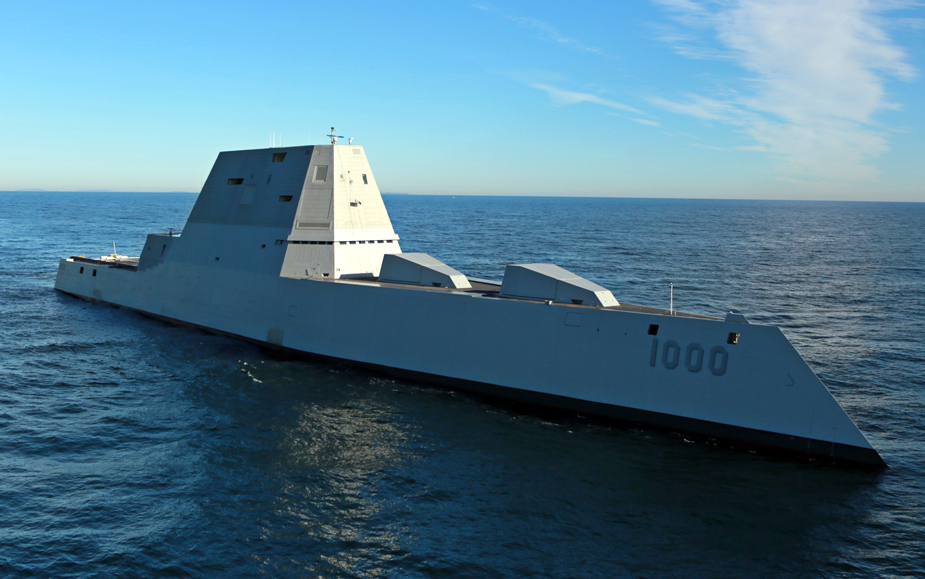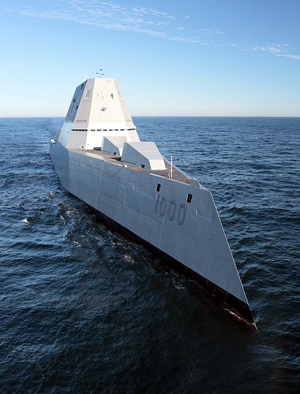
USS Zumwalt Begins Sea Trials
| published December 8, 2015 |
By R. Alan Clanton, Thursday Review editor
In this photograph provided by General Dynamics and the U.S. Navy, the newly christened destroyer USS Zumwalt sets to sea on December 7 from the Bath Iron Works facility in Bath, Maine. The Zumwalt is cruising into the Atlantic Ocean for the first of a series of equipment tests, at-sea trials and weapons testing.
The U.S. Navy characterizes the top secret Zumwalt as a “multi-mission, mutli-task” ship, built for “forward presence and deterrence,” and capable of specialized missions ranging from integration into special operations assignments to collaboration with much larger combined forces. If the ship proves its mettle during sea trials, the Navy would like to build at least two more—far short of the original Pentagon plan of some 32 new destroyers with the Zumwalt as flagship of the class. Congress cancelled the 32-ship plan last year, scaling the whole program back to just two—for now.
The Zumwalt in the photo cost American taxpayers a mere $3.5 billion.
Among its notable distinctions: the 600-foot long, 80-foot wide Zumwalt is the largest destroyer ever built by the U.S. Navy, and at 15,000 tons, it rivals even many older aircraft carriers and battleships in weight and mass. The Zumwalt also bristles with cutting edge communications, computer and imaging technology, and is loaded with some of the most powerful and expensive weapons ever placed aboard a ship. Don’t bother looking for those weapons—the Zumwalt’s sleek, futuristic lines keep all weapons shrouded from view behind panels and doors which open only when the weapons are ready to be fired. Among the not-so-secret weapons capability on board: 80 launch cells or ports through which Sea Sparrow missiles, Tomahawk cruise missiles, anti-sub rockets, and other lethal ordnance can be fired.
The Zumwalt also possesses two 155 mm/62 caliber Advanced Gun Systems (manufactured by BAE Systems) which were designed more-or-less specifically for the Zumwalt-class of new destroyers. The guns can fire a 6.1 inch shell at a high rate of fire with extreme accuracy even at targets over-the-horizon. Using a water-cooling system, the gun can fire 10 projectiles per minute. The gun initially weighed more than 100 tons, but over the last several years it was carefully redesigned for Navy use; its new weight, for shipboard purposes, is classified, as is its exact range at sea. What is known is that on land the gun can fire roughly 85 miles. (A Wikipedia article defines the gun’s range at sea as 83 nautical miles, but only if using a “long range land attack projectile,” which seems to muddy both the question and the answer.)
Among the long-range thinking behind the Zumwalt class of destroyers was talk of eventually fitting the ships with electromagnetic rail-guns—futuristic weapons under development and testing by several contractors, but inching closer to reality with each passing month. The rail gun (which, despite its namesake, has nothing to do with railroads and everything to do with electricity), can hurl ordnance at seven times the speed of sound and at sea ranges of more than 100 miles. Even at that range, the rail gun will be accurate to within a few inches, especially when its targeting software is coupled with satellite technology and imaging technology already routinely used in cars, SUVs and smart phones. The rail gun uses electricity, as opposed to gunpowder and chemicals, as its means of propulsion. Though the rail gun is expensive per unit, the Pentagon boasts that it can save money during wartime. Why? Because ordnance fired at Mach 7 requires no explosives, no chemicals, no warheads, no fuses, no fuss; the impact of an object traveling at Mach 7 is far more lethal on its own. At seven times the speed of sound, a ceramic coffee mug or a solid glass paperweight could destroy a Russian bomber just as easily as a speedboat piloted by ISIS fanatics. For these reasons, the smart thinkers at the Pentagon want the rail gun aboard every new ship in the 21st century U.S. Navy. But with the rail gun months away from regular production, the Zumwalt set to sea without one (though one would have to take a peek behind those sealed doors to be sure).
The Zumwalt is also a stealth ship, and though technically it can still be seen using many modern forms of radar, it is designed—in theory—to disguise itself as something far smaller and less menacing than the Star-Wars-Meets-Master-And-Commander monster it really is. To a typical radar, it may appear to be a large yacht, perhaps, or a small fishing trawler. That’s what the Pentagon had in mind when the $22 billion-plus project got under way several years ago. Still, the “stealth” ship is far from invisible, as had been the early prognostications of its earliest designers and promoters (much as the jet fighter F-35 Lightning is not truly invisible to enemy radar, as its designers had intended).
 At first glance, the Zumwalt’s strange contours and space-age lines seem counter-intuitive. The silhouette one sees above the waterline appears more like the hull of a ship—as if the whole thing is upside-down. In fact, the strange shape and unique hull are part of a retro design, not for style or futuristic appearance, but as a component of its stealth technology. The narrow prow and slender shape help it to not only slice through the water at a hearty clip, but it also helps to reduce the size of the wake (compare that to the newly christened USS Milwaukee, a combat littoral ship which can travel at 45 knots but kicks up a walloping five-foot wake). The razor thin design also adds to the stealth component, making it very difficult (if not impossible) to correctly interpret the oncoming shape.
At first glance, the Zumwalt’s strange contours and space-age lines seem counter-intuitive. The silhouette one sees above the waterline appears more like the hull of a ship—as if the whole thing is upside-down. In fact, the strange shape and unique hull are part of a retro design, not for style or futuristic appearance, but as a component of its stealth technology. The narrow prow and slender shape help it to not only slice through the water at a hearty clip, but it also helps to reduce the size of the wake (compare that to the newly christened USS Milwaukee, a combat littoral ship which can travel at 45 knots but kicks up a walloping five-foot wake). The razor thin design also adds to the stealth component, making it very difficult (if not impossible) to correctly interpret the oncoming shape.
In fact, the hull’s design bears a remarkable resemblance to hulls used on ships more than 100 years ago—a hull configuration which proved sometimes unstable. The basic shape, called a “tumblehome,” is that of the great dreadnoughts of the early 20th century—behemoths with hulls slightly wider at and below the waterline than what is seen above. Those hulls disappeared over time as the world’s navies moved to the more reliable and traditional V-shaped hulls. The last major use of the tumblehome was in 1910.
And according to some engineers and analysts, stability may become a significant problem for the mega-expensive Zumwalt as well—an issue its designers say the ship’s first major sea trials will dispel. The Atlantic can be a notoriously bumpy ride for any ship, even the most stable, so the first most basic test for the Zumwalt will be its ability to remain upright in heavy seas and high swells. Also at issue: the ship’s stability in sharp or high speed turns, a bugaboo of the tumblehome design on the last century, one which was never resolved and which led to the demise of the hull shape.
General Dynamics, Bath Iron Works, Huntington-Ingalls, and dozens of other contractors and designers say not to worry—the Zumwalt can take on whatever the sea throws at her. In addition, the builders have equipped the ship with state-of-the-art computerized stabilizers, custom-designed to help manage the ship’s poise even in extreme seas and in combat. Small models, and later larger scale models, were used in extensive testing to prove to the skeptics that the ship can remain upright despite the exotic design. Mind-boggling swells and enormous waves were thrown at the models to prove the point.
But the Zumwalt’s design critics—which are many—contend that the real-world conditions found in the seas, even in times of peace, can be dangerous and challenging. Both sides in the debate will wait to see how the Zumwalt performs in sea trials in the North Atlantic; promoters of the ship say she will perform with excellence; some doubters question whether billions of dollars in secret hardware will end up littering the bottom of the seas after the ship rolls over in rough weather and high waves.
The Zumwalt, at a staggering $3.5 billion (yes, billion), is also one of the most expensive weapons platforms ever conceived or constructed. Part of that cost goes into its cutting-edge weapons, but much of the cost has also gone into its powerful, muscular propulsion system. The Zumwalt uses a pair of Rolls-Royce MT30 gas turbines to drive its Curtiss-Wright electric generators, which in turn propel the blades. Speed was essential in the Pentagon’s thinking for a new century Navy; the Zumwalt, if all goes well in testing, will be able to cruise at about 35 miles per hour. That gives it a quick response time if it is needed in a crisis—the South China Sea, for example, or off the coast of South Korea.
Also concealed by its shroud of steel panels and closed doors: room enough for up to two helicopters in an enclosed hangar. Zumwalt-class destroyers will carry as standard equipment at least one helicopter on its flight deck.
Related Thursday Review articles:
USS Milwaukee is Commissioned; Keith H. Roberts;Thursday Review; November 23, 2015.
Graduation Day, Annapolis; Thursday Review staff;Thursday Review; May 22, 2015.
